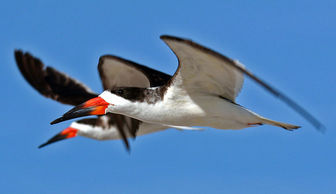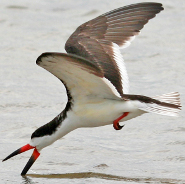Black Skimmer
The Black Skimmer breeds in loose groups on sandbanks and sandy beaches in the Americas, the three to seven heavily dark-blotched buff or bluish eggs being incubated by both the male and female. The chicks leave the nest as soon as they hatch and lie inconspicuously in the nest depression or scrape where they are shaded from high temperatures by the parents. They may dig their own depressions in the sand at times. Parents feed the young almost exclusively during the day with almost no feeding occurring at night, due to the entire population of adults sometimes departing the colony to forage. Although the mandibles are of equal length at hatching, they rapidly become unequal during fledging.

The Black Skimmer - Skimming in Flocks
 The Black Skimmer (Rynchops niger) feeds by skimming the surface of the water with its long lower mandible.
The Black Skimmer (Rynchops niger) feeds by skimming the surface of the water with its long lower mandible.
Native to the Americas, the Black Skimmer measures about 40 to 50 cm (15.75 in - 19.70 in) as an adult with a wingspan of 107 to 127 cm (42 in - 50 in). The adult male weighs about 325 grams (11.5 oz) as compared to the smaller female of about 235 g (8.3 oz).
In North America, the Black Skimmer breeds in the warmer waters of the Atlantic and Pacific coasts. In South America, the breed migrates mainly in reaction to seasonal flooding. A seabird, this species inhabits sand or gravel beaches and bars, estuaries, and salt marshes.
In appearance the Black Skimmer resembles a tern and is black on top with white underside. The bill is bright red with black tip, and the long, narrow wings are dark on top and grayish below. The legs and feet are red, while the tail is white with a black center. The bird’s call is a “kak kak kak” or “kur kur kur.”
The Black Skimmer is the only bird species in the United States in which the lower mandible is longer than the upper mandible. Upon hatching, the two mandibles have the same length but henceforth the lower mandible grows until it is much longer than its counterpart. The birds generally feed during the day, flying just over the water’s surface in order to dip their lower mandible and “skim” for prey including fish, insects and shellfish.
Predators can include dogs, foxes, cats and raccoons, and humans looking for eggs. The eggs are also vulnerable to flooding and ecological disturbance by humans. Human development and traffic along beaches can threaten the bird's nesting grounds, as the species is sensitive to even minor disturbances during breeding.
The species can be divided into three subspecies: Rynchops niger niger, located from southern California to Ecuador on the Pacific coast, and along the North American Atlantic coast; Rynchops niger cinerscens, a larger subspecies located on the Atlantic coast of South America; and Rynchops niger intercedens, also located on the South American Atlantic coast down to Argentina.
The species is listed under the category of Least Concern after a prior rating of Lower Risk. The current population of Black Skimmers is estimated at about 200,000 individual birds, and the population has remained stable for the last decade.
Picture of the black skimmer by Googie man, licensed under GFDL
The Black Skimmer is classified as Least Concern. Does not qualify for a more at risk category. Widespread and abundant taxa are included in this category.

Family : Laridae
Genus : Rynchops
Species : niger
Authority : Linnaeus, 1758

